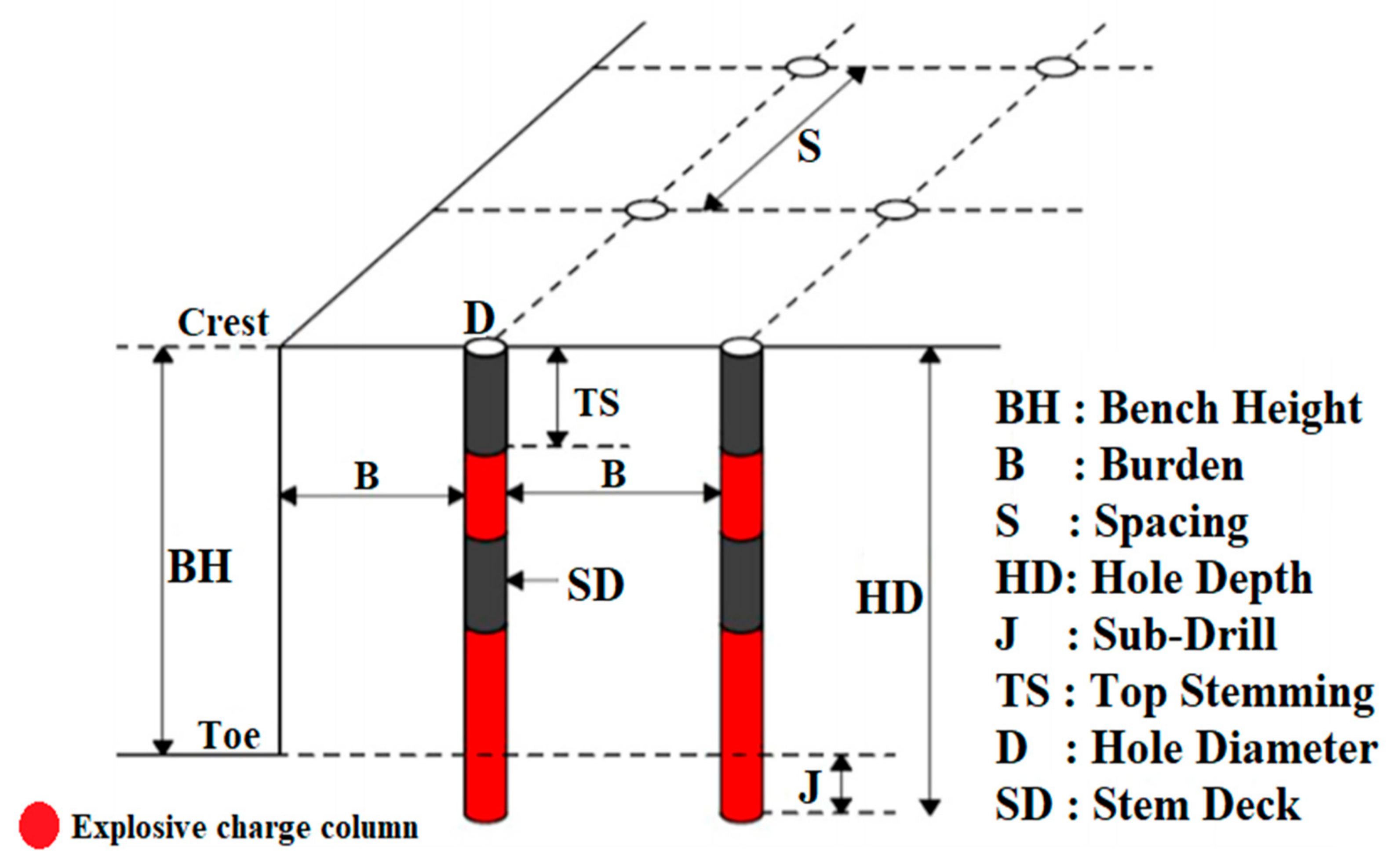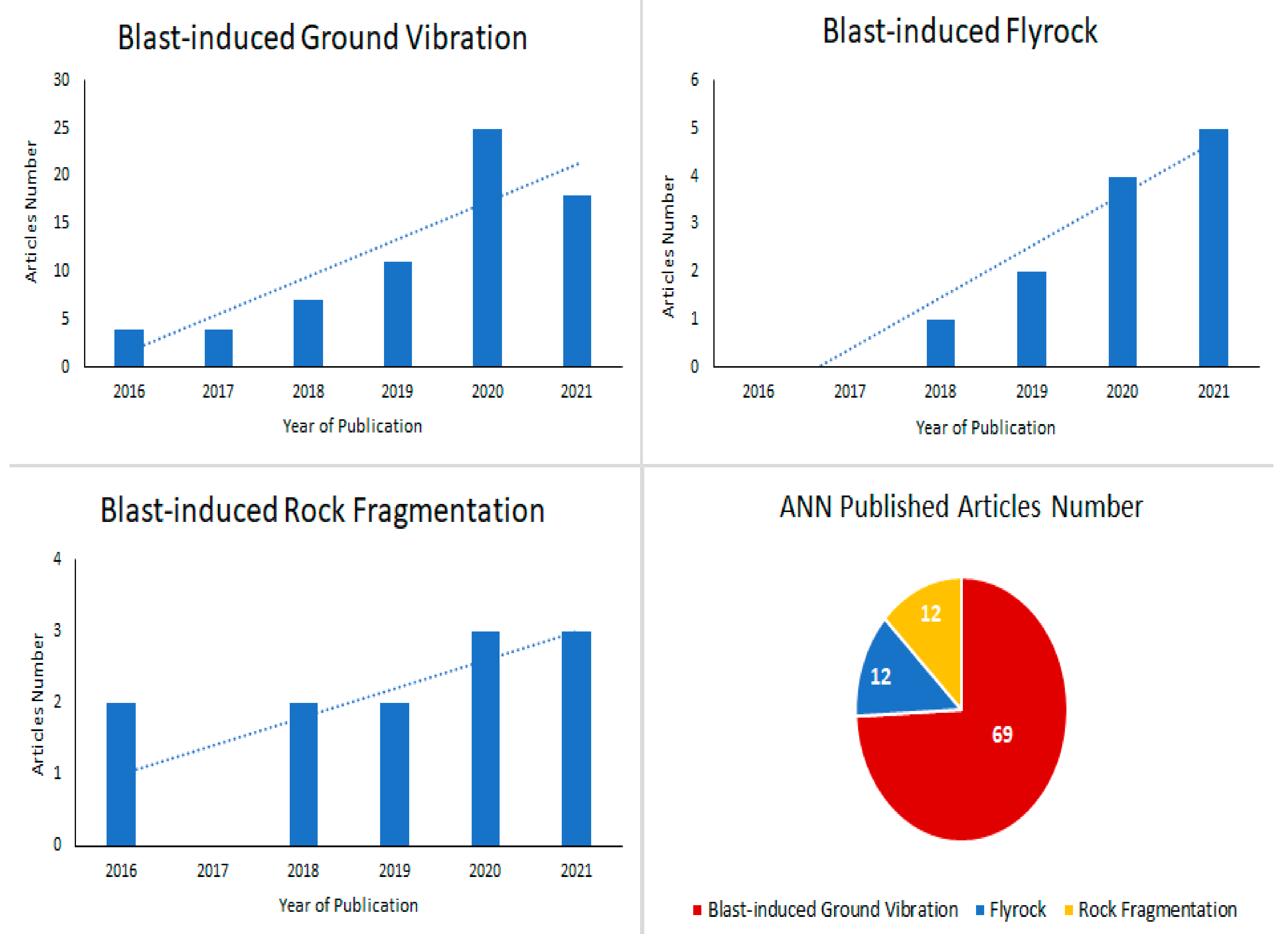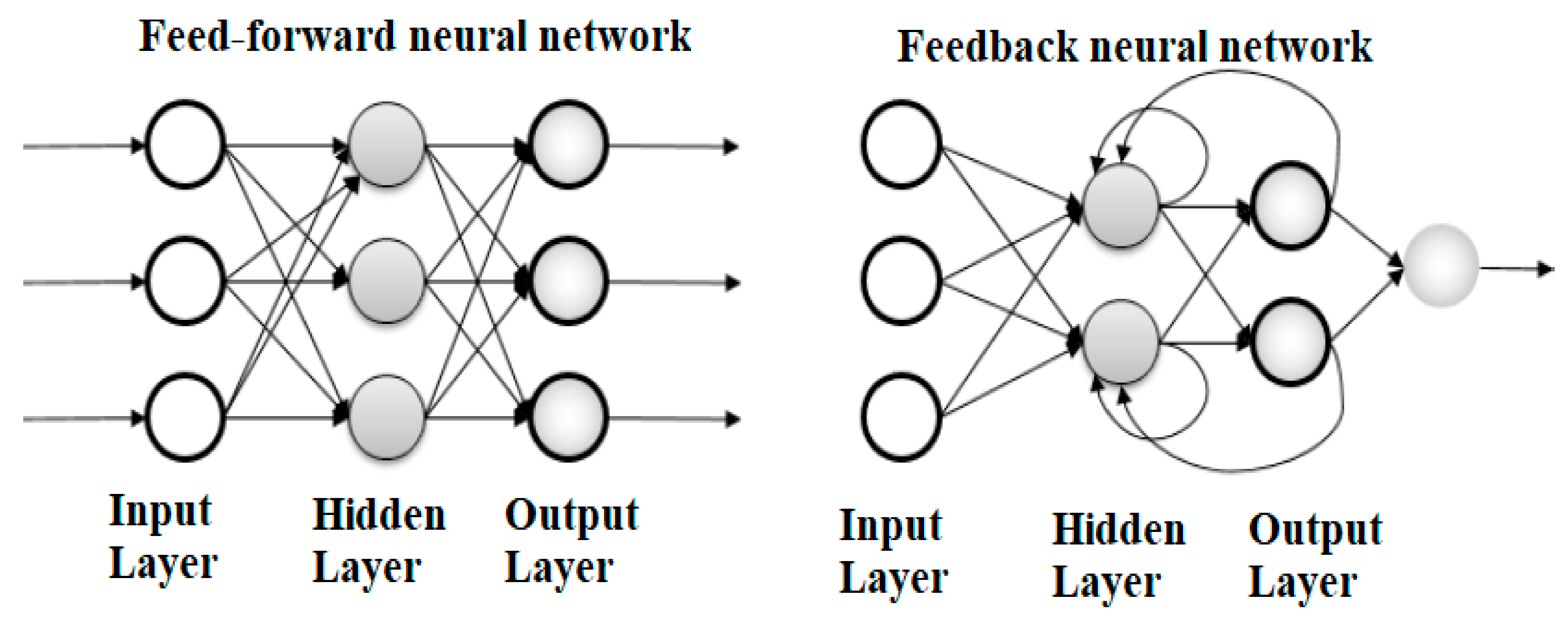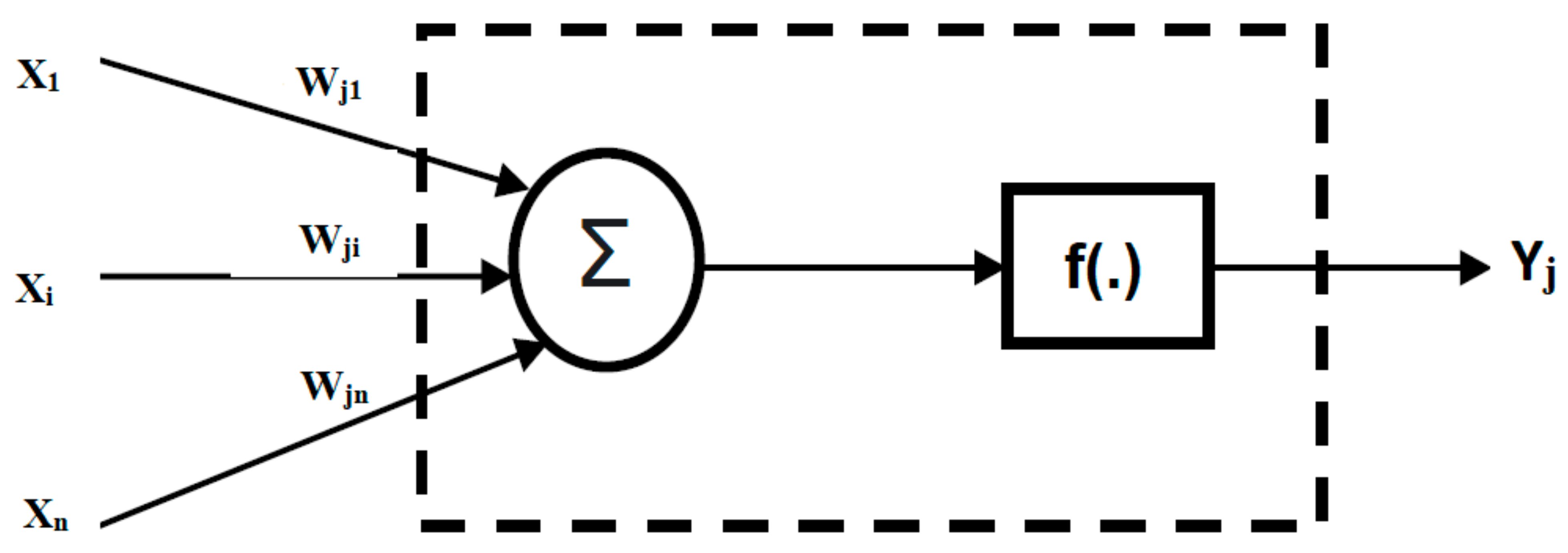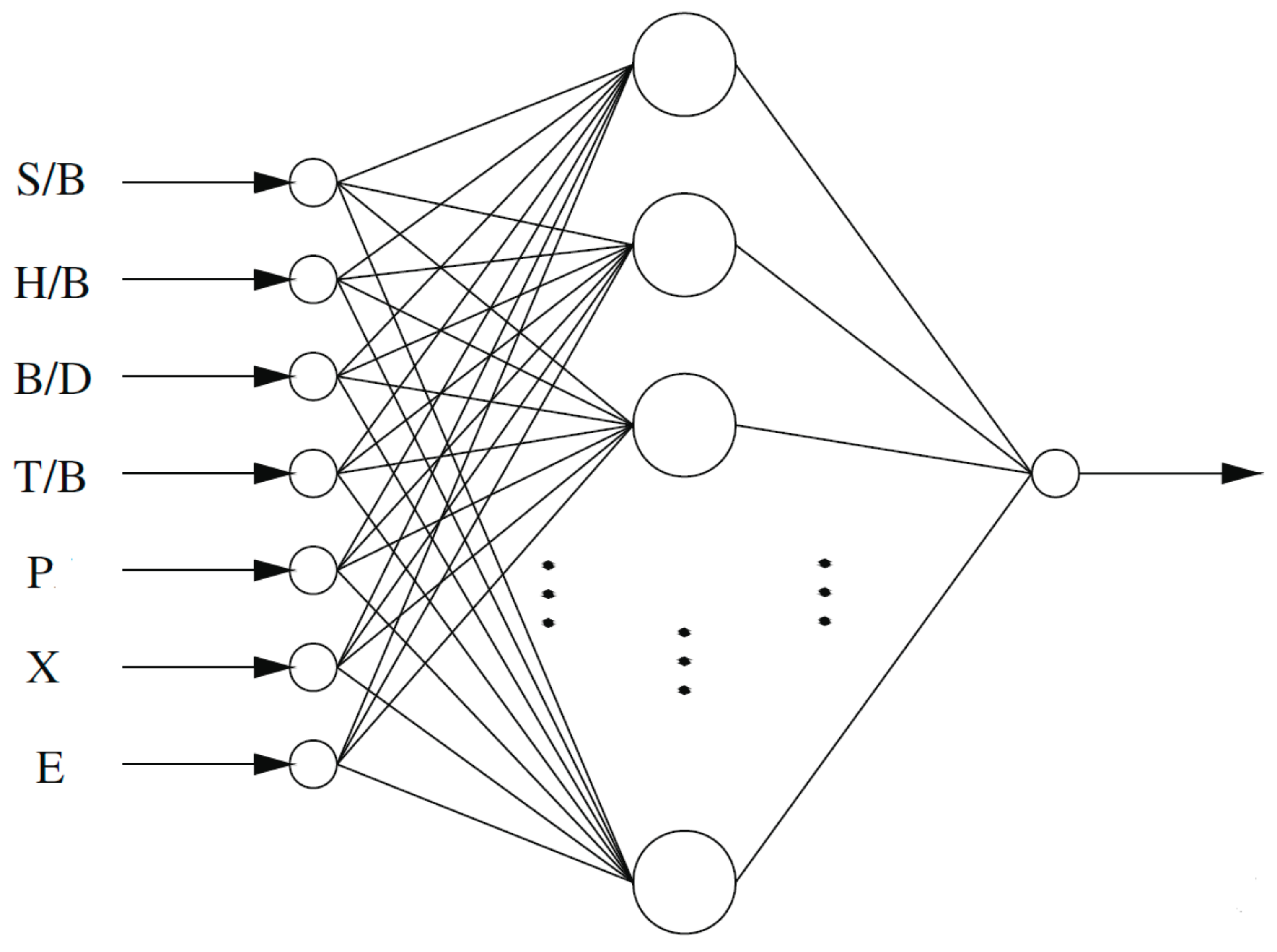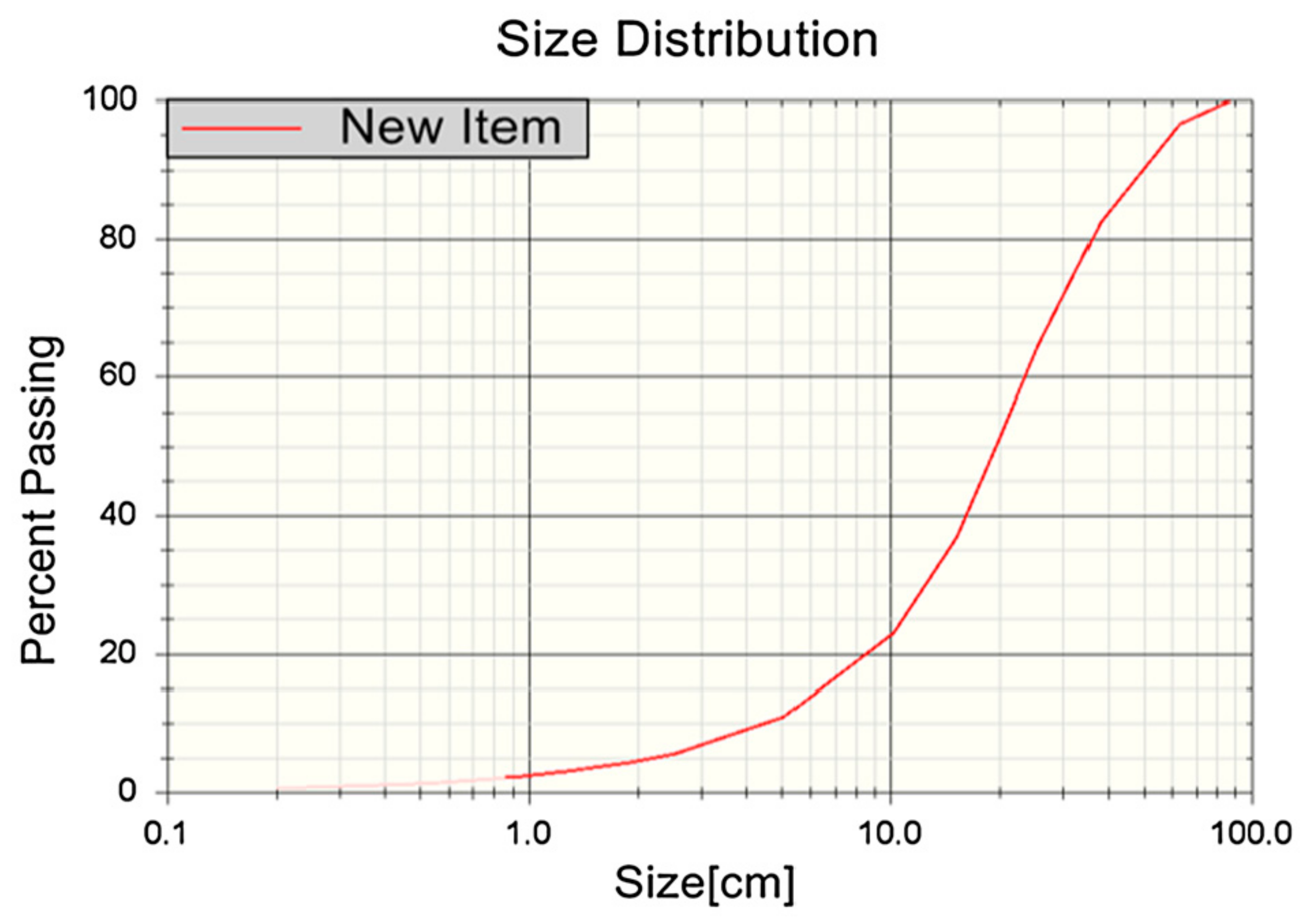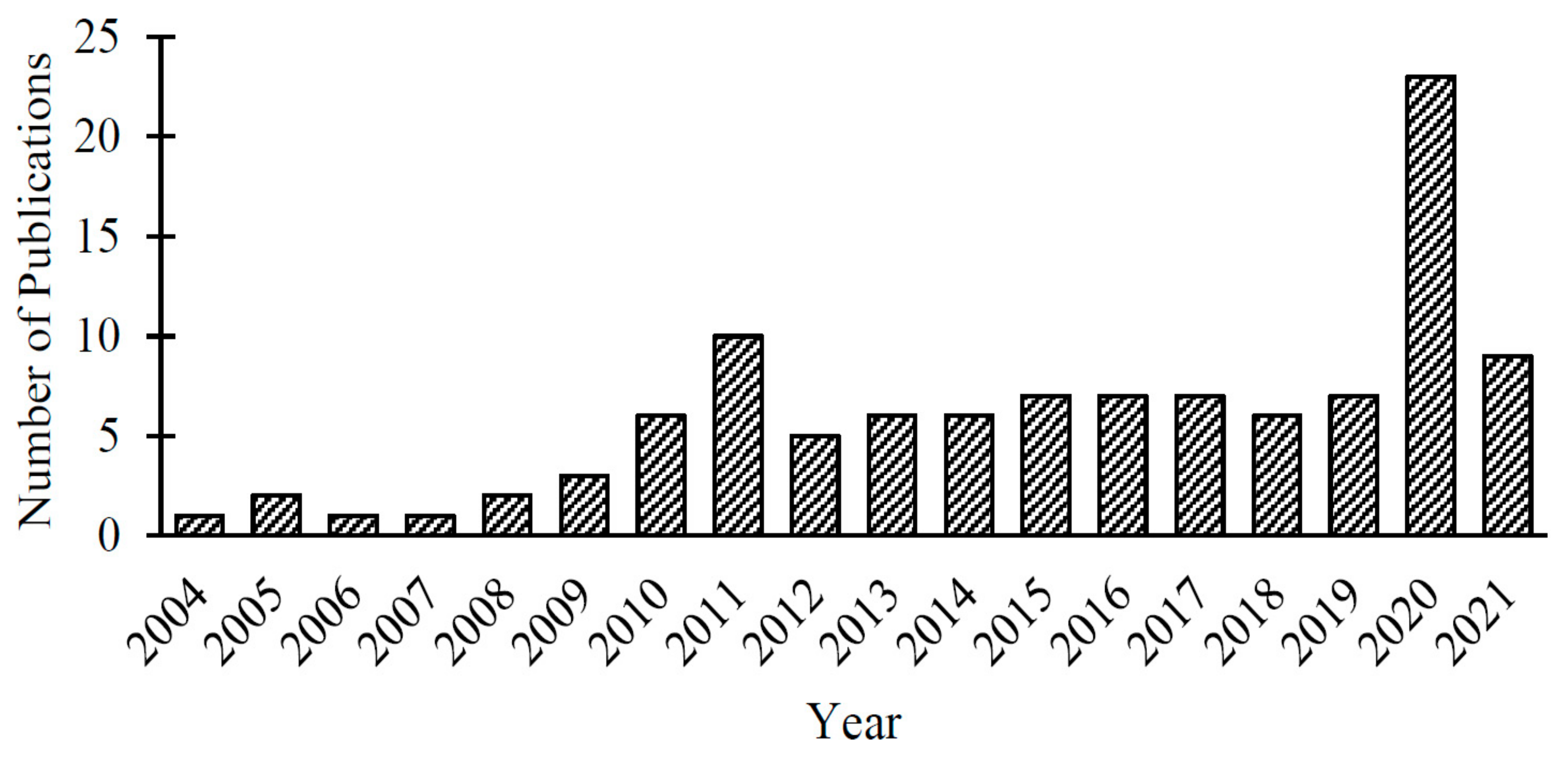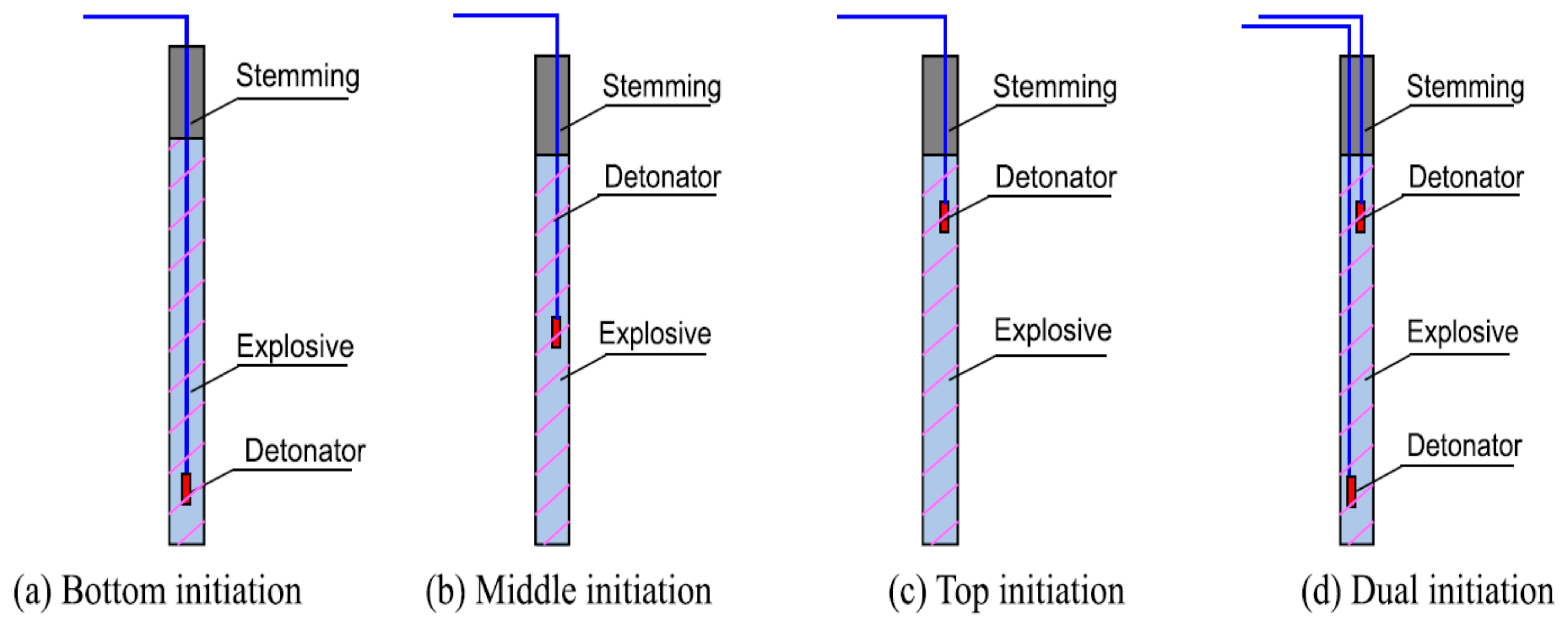4.1. Applications of ANN in Blasting Events
Over the recent few years, the artificial neural network (ANN) technique has led to a technical revolution in mining and related branches of engineering [
52,
53,
54,
55]. In addition to the high capability to solve complex engineering problems, ANN prediction can apply in a large spectrum of applications in mining. Neural networks can provide numerical solutions in various mining operations, such as geophysical data interpretation, minerals processing, equipment selection, underground mining method, blasting optimization, blasting environmental impact, net present value, etc., [
51,
56,
57,
58,
59,
60,
61,
62]. Blasting operations imperative raise safety concerns and negatively impact the surrounding environment. As an optimization tool, the artificial neural network technique has the capability of predicting the blasting-induced undesirable impacts, including flyrock, ground vibration, and back-break [
63,
64,
65].
Flyrock is a hazardous event and considerable concern resulting from blasting operations in surface mines [
66,
67,
68]. Several empirical models have developed to control and eliminate the hazards of flyrock through the prediction. However, due to flyrock analysis complexity, empirical models performed poorly [
69]. The artificial neural network method was used and highly recommended by Monjezi et al. (2009) as a new approach for flyrock perdition and controlling [
70]. The investigated case study was for 192 blast datasets in an iron mine. They applied feedforward propagation (three layers) for nine inputs, 13 hidden neurons, and one output (flyrock) in
Table 1 [
70]. The results showed that flyrock generation minimized from 165 m to 25 m. And based on obtained results, the authors conclude that an artificial neural network with an optimum architecture 9-13-1 and RMSE 0.67 can be effectively used as an intelligent tool for flyrock prediction and control in this study.
Flyrock distance has measured for 16 boulders, and then the ANN model was developed based on blasting parameters in a granite quarry by Mohamad et al. (2012) [
71]. In this study, eight input parameters were considered (charge length, powder factor, explosive amount per hole, stemming, burden, hole angel, hole depth, and hole diameter) as main blasting parameters. In addition, two hidden layers and one output to design a prediction model by a feed-forward network. Results revealed that the ANN technique with an optimum architecture 8-15-15-1 could produce an accurate prediction compared to empirical methods supported by a very high correlation coefficient (about 0.92) and a low value of error system (about 0.04%) in
Table 2 [
71].
Ghasemi et al. (2014) constructed flyrock predictive models for 230 blast datasets in a copper mine by employing two artificial intelligence techniques: artificial neural network and fuzzy logic [
72]. Six input parameters, one hidden layer with nine neurons, and one output were used with the feed-forward backpropagation method to design an ANN predicted model in
Figure 7 and
Table 3. The study concludes that both developed models are efficient, but the fuzzy model has more reliability in the predictions compared to the ANN model in
Table 4.
Trivedi et al. (2014) used 95 datasets collected from a limestone mine; the flyrock predicted model has developed by an artificial neural network (ANN) based on six input parameters, two hidden layers, and one output in
Table 5 [
73]. And by comparing to another model developed by multi-variate regression analysis (MVRA), the ANN model has been proven to be an excellent model in
Table 6. Thus, the investigated study illustrated that the ANN technique has superiority as a prediction tool for flyrock.
Ground vibration induced during blasting operations is a considerable safety concern since it harms nearby structures such as buildings, roads, dams, etc., [
74,
75]. Control and prediction of blasting vibrations are very significant steps to mitigate that adverse effect [
35,
76,
77].
A proposed attempt of using an artificial neural network (ANN) for ground vibration prediction has been made successfully by nine inputs, six neurons in the hidden layer, and one output with a backpropagation network Singh et al. (2005) [
78]. The study concluded that a great potential by ANN tool for accurate prediction of ground vibration as a complex geotechnical problem. While well as in power plant and dam rock excavation projects, artificial neural networks ANNs used for blasting-induced vibration prediction Kamali et al. (2010) [
79]. The constructed neurons architecture was nine inputs, fifteen neurons in a hidden layer, one output. Researchers in the comparative study compared ANN to empirical and MVRA modeling results, then presented that ANN is the best approach for blasting-induced vibration prediction.
Recently, Paneiro et al. (2021) have proved the high prediction ability of ANN in the ground vibration field [
80]. The study considered 1114 observations collected from blasting operations to develop a dataset. The architecture has built on 17 inputs parameters, one hidden layer with 12 neurons, and one output. The obtained ANN model demonstrated high reliability compared to traditional models. Similarly, the ANN approach applied 100 datasets acquired from five selected granite quarries by Lawal et al. (2021) [
81]. The study considered peak particle velocity as a targeted output through five parameters input. And then achieve the best performance with a low error in the proposed hybrid ANN model. Moreover, the applications of the ANN technique in blasting induced-ground vibration prediction showed in many investigation studies [
21,
82,
83].
Back-break is undesired rock breakage that can be resulted beyond the last row of holes in the blasting pattern. Back-break phenomena can affect the stability of surrounding rocks and walls. However, back-break prediction is a realistic solution to avoid that unwanted event induced while blasting. In addition, prediction can introduce an added value in technical and economic sides [
8,
84,
85].
Monjezi et al. (2008) performed a case study in an iron mine using artificial neural network ANN to determine the best blasting pattern, thus reducing the back-break effect [
86]. The architecture was four layers that comprise seven neurons in the input layer, 15 and 25 neurons in two hidden layers, respectively, and one neuron in the output layer. Multilayer perceptron (MLP) was applied to analyze parameters and achieve the optimum blasting pattern. Results showed that the parameter of stemming to burden ratio plays a significant role in back-break. Optimization of the stemming/burden ratio led to a reduction in back-break from 20 to 4 m. Finally, the study highlighted that ANN is a handy optimizing tool and can keep blasting operations in open-pit mines more efficient.
A comparative study was carried out in limestone mines to utilize some types of ANN for back-break prediction Sayadi et al. (2013) [
85]. The neural network was adopted for the simulation by backpropagation (BPNN) and radial basis function (RBFNN), trained both predicted models using 103 datasets. Spacing, burden, bench height, stemming, specific drilling, and specific charge used as input examined parameters to achieve a high-reliability prediction model. The study observed that the spacing and burden input parameters mainly impact the output, whereas the specific charge has a limited effect. Also, the investigation study found that the BPNN model has more accuracy and lees errors comparing to the RBFNN model [
85].
Monjezi et al. (2013) conducted another study in an iron mine to investigate the influence of input parameters on the back-break as an output [
87]. The investigation demonstrated the superiority of ANN, and obtained results revealed that the burden parameter has more effectiveness on back-break [
87].
Furthermore, the capability of ANN for back-break prediction in tunneling was well-proven Koop. et al. (2019) [
88]. The examination study strongly presented ANN as a powerful tool that solves complicated problems such as back-break phenomena as one of the main issues in tunnel construction projects. Three layers in the neural network were found and optimized by an artificial bee colony algorithm (ABC) with 255 utilized datasets collected from actual operations. Finally, the results showed that back-break minimized and good tunneling operations can be accomplish using ANN [
88].
Table 7 summarizes some critical research articles published in predicting flyrock, ground vibration, and back-break using ANN. Moreover, it illustrates the study area and the performance of the developed model.
4.2. Rock Fragmentation Prediction
Blasting operations through the resulted fragmentation are of great importance in mining and related rock excavation projects, as they directly impact the productivity and overall costs of subsequent operations [
89,
90]. Over three decades, significant attempts have been made in blasting technology development to introduce sophisticated blasting operation performance prediction [
5]. Prediction of blast-induced fragmentation is an essential aspect of achieving optimized blasting operation and reducing overall cost. However, numerous factors such as geotechnical parameters of rock, explosives properties, and blasting geometrical parameters can affect rock breakage and govern prediction performance [
91,
92]. And since the large number of variable parameters that influence rock breakage and complexity in their interrelation, it is impossible to design a comprehensive formula. Various empirical models are present in the literature context, but they are more complicated or lack accuracy and reliability [
11,
93,
94,
95].
Recently, many contemporary scholars have introduced artificial neural networks (ANNs) as new and reliable technology in several complex applications under blasting; thus, they successfully utilized this technique and overcame the drawbacks of empirical models prediction [
61,
96,
97,
98,
99,
100,
101]. Despite accelerated development in blast-induced events prediction applications, predicting the resulted rock fragmentation remains the most critical concern; as stated previously, it plays a vital role in the overall economy of whole mining operations through cost reduction and profit optimization [
13]. Presently, artificial neural network (ANN) is frequently applying in this field due to its high engineering problem-solving capability. The development of an accurately predicted model for rock fragmentation significantly contributes to achieving efficient blasting through the optimum blast design. Therefore, it promotes productive operations, improved blasting induced-desirable impacts, and safe procedures for mining or other excavation projects [
101,
102]. In the last decade, various studies reported in the literature as successful application models of artificial neural networks in blast-induced fragmentation prediction. Each study investigated and designed the predictive model from a different perspective to solve the improper fragmentation problem.
Bahrami et al. (2011) used 220 datasets collected from practical operations in iron ore mines to develop a rock fragmentation model [
11]. The study incorporated ten parameters: Spacing (S), Burden (B), Hole Diameter (D), Hole Depth (HD), Stemming (T), Specific Drilling (SD), Blast Ability Index (BI), the Charge Per Delay (CD), SMR, and Powder Factor (PF). Backpropagation algorithm applied and introduced as a more efficient technique for multi-layers learning consisting of three layers or more: input, hidden, and a hidden layer [
103]. For optimum network identification, many topologies tried and then selected four layers with 10-9-7-1 architecture as an optimum network model based on the lowest value of root mean square of error, abbreviated RMSE, and the high value of the coefficient of determination (R
2). The researchers tested the proposed model by around 10% of datasets and fulfilled the sensitivity test (cosine amplitude method) to recognizing the most sensitive input parameters affecting rock fragmentation [
104,
105,
106]. Obtained values of RMSE and R
2 were equal to 0.56 and 0.97, respectively. And sensitivity test results indicated that input parameters including burden, powder factor, blast ability index, SMR, and charge per delay significantly impact rock fragmentation.
Kulatilake et al. (2012) collected data of 109 performed blasts from various quarries (previous study) to develop the fragmentation prediction model by neural network and multivariate regression methods [
107,
108]. Development of model used around 89% of data and 11% used to validate the model. In this investigation, the authors considered ratios between five parameters of blast design: Spacing (S), Burden (B), Stemming (T), Hole Diameter (D), and Bench Height (H) as main parameters for model development. Moreover, considered the Powder Factor (PF) as a parameter belongs to explosive material, Modulus of elasticity (E), and Size of in situ blocks (X). Both prediction methods developed a model based on seven input parameters: B/D, T/B, S/B, H/B, X, E, and P in
Figure 8. Backpropagation network with a single hidden layer applied for fragmentation prediction. The study found 7-9-1 architecture to be the optimum network model. In neural network prediction, the value of RMSE was 0.0429, while R
2 was equal to 0.94, which means robust matching between ANN prediction and measured values. According to obtained results, the study concluded that the model’s capability developed by the neural network is superior comparing to the multivariate regression model.
Sayadi et al. (2013) conducted a comparative study to compare the performance of neural networks for blasting-induced rock fragmentation prediction in limestone mines by adopting backpropagation (BPNN) and radial basis functions (RBFNN) [
85]. The study utilized 103 datasets collected from blasting operations in the cement company mine. The neural network used 90% of the collected datasets in the training and 10% for model testing. Controllable input parameters including Spacing (S), Burden (B), Specific Charge (SC), Specific Drilling (SD), Bench Height (H), and Stemming (T) were used as input parameters to develop both models. The model achieved optimum results in the BPNN method (RMSE = 0.22 and R
2 = 0.871) with 6-10-2 architecture. And 6-36-2 architecture for RBFNN model with spread factor equal to 0.79. The sensitivity test obtained results showed that burden and stemming have a significant impact on blasting-induced rock fragmentation. As a conclusion of the comparison investigation, the authors demonstrated that the backpropagation neural network model (BPNN) provides more accurate predictions than the RBFNN model.
Enayatollahi et al. (2014) studied 70 blasting patterns gathered from iron mines. Researchers then evaluated the developed prediction model created by two methods: multiple regression analysis and artificial neural network [
109]. Sixty datasets did a neural network training to determine the optimum fragmentation prediction model and ten datasets for model testing. Set of input parameters utilized to design the network incorporating Burden (L), Bench Slope (D), RQD (J), Tensile Strength (K), Hole Depth (A), Specific Drilling (C), Water Depth (F), Stemming (G), Spacing to Burden ratio (E), Blasting Rows (I), the Charge per Delay (H), Powder Factor (B). Many studies deeply investigated the influence of some previous parameters on blasting performance [
110,
111,
112,
113].
A multilayer perceptron with two layers was examined in the evaluation study and then selected to determine the appropriate neural network architecture. The structure was found by 12-15-11-1 with low errors in the predicted model. It achieved a minimum value of RMSE (around 0.50). Furthermore, a high value of R2, which reached 0.98, illustrated a robust matching between the predicted and measured models. The gained results indicate the artificial neural network technique possessed a great accuracy in fragmentation prediction. And finally, the study results showed that stemming is the most parameter affecting rock fragmenting.
Dhekne et al. (2014) reviewed and provided a piece of general information about the artificial intelligence (AI) approaches successfully implemented to predict rock fragmentation in mining operations [
56]. The review paper discussed essential elements of the artificial neural network and its broad-spectrum applications in mining. Eventually, discussion outcomes concluded that besides some drawbacks related to developing prediction models using neural networks, e.g., datasets large quantity requirement. Also, this technique has distinct benefits relative to regression models, such as high flexibility, non-linearity, adapting in learning, clarity, and excellent prediction accuracy. Therefore, researchers highlighted the need to develop new adaptive models to solve more complicated problems in the rock fragmentation prediction area.
Ebrahimi et al. (2016) have applied an artificial neural network in lead and zinc mines to optimize the blasting-induced rock fragmentation [
23]. They set spacing (S), burden (B), hole depth (L), stemming (ST), and powder-factor (PF) as system inputs parameters. Moreover, the considered parameters have a significant influence on rock fragmentation, as stated. Split-Desktop software was used to analyze the digital images of fragmentation and then found that size distribution range 15–40 cm in
Figure 9. The neurons architecture was 5-5-4-2 for 34 collected datasets, and the obtained values of RMSE and R
2 were 2.76 and 0.78, respectively. After this attempt, the authors illustrated the superiority of the ANN approach in the prediction of rock fragmentation. Furthermore, mentioned the high capability of the ANN tool, which can contribute to achieving optimized rock fragmentation.
Many researchers efficiently analyzed high-quality digital images using the Split-Desktop tool to study blasted fragments [
114,
115,
116]. The indirect method of determining fragmentation particle size by Split-Desktop system involves five stages: image scaling, rock fragments segmentation dedicating, issuing permission to edit the rock fragments, analyzing the marked pieces, and the final phase is displaying the digram of size distribution results.
Split-Desktop system has a package of advantages being applying scales on the image up to three bodies, image resolution changing, dealing with pictures in several extensions, and exporting the obtained size distribution results to excel, etc. In terms of getting more accurate results, the acquired field image should cover the whole fragments range, not affected by shade or light, and the while imaging lens of the camera placed as usual to the mass of fragmented rock [
116].
Tiile (2016) conducted an approach to predict blast-induced rock fragmentation in gold mines using the artificial neural network [
117]. Seven input parameters used comprising Hole Diameter (D), the ratio of Spacing to Burden (S/B), Distance between monitoring point and blasting area (DS), Hole Depth (HD), Stemming (T), Charge per Delay (CD), and Powder Factor (PF). The study applied a backpropagation algorithm with feed-forward in three-layer neural networks. And the designed optimum model of rock fragmentation prediction was found by 7-13-3 architecture with 0.316 and 0.997 for RMSE and R
2 values, respectively. The obtained outcomes of the sensitivity test showed that diameter and spacing to burden ratio are more effective input parameters on rock fragmentation. Moreover, comparing to MVR and empirical methods, the ANN prediction model was proven to be superior. The developed model successfully reduced fragments size from 0.70 m to 0.45 m. Thus, achieved a 31% improvement in crusher productivity and 37% in excavators.
Murlidhar et al. (2018) described a new hybrid predictive model for rock fragmentation in an aggregate quarry consisting of a limestone deposit [
118]. Artificial neural network (ANN) and imperialist competitive algorithm (ICA) have combined to investigate the impact of ICA on ANN through obtained results comparison. This study built models based on eight input parameters include block size (XB), powder factor (PF), rock quality designation (RQD), and the maximum charge per delay (MC). In addition, the ratio of the following parameters: spacing to burden (S/B), bench height to burden (H/B), stemming to burden (T/B), and burden to the hole diameter (B/D). The hybrid ICA-ANN model used a hundred eleven datasets, 80% for development and 20% for testing. The achieved lowest RMSE, and highest R
2 values were with 8-10-1 architecture. The results showed high reliability of the hybrid ICA-ANN model in rock fragmentation prediction with values of 0.944 and 0.813 for R
2 and RMSE. In comparison, the obtained values of ANN itself were 0.941 and 0.819.
Ultimately, by looking at the outcomes of this investigation, it can note that the simple difference between the values of the two developed models is evidence of the high performance of the artificial neural network even applied alone. Thus, it is a consolidation of its great potential in the prediction field.
Another approach successfully conducted by Dimitraki et al. (2019) in aggregate quarries in Thessaloniki, Greece, aimed to predict the average fragmentation size of blasted rock [
119]. The study focused on the blasting process and engineering geological parameters’ effect on blasting-induced fragmentation using artificial neural network prediction; from a geotechnical perspective, geological factors influence has been discussed thoroughly in several types of research [
120,
121,
122]. These study authors attended hundred blasting operations evenly distributed over both quarries to collect data for predictive models’ development separately, under backpropagation algorithm training. They utilized thirty-eight datasets for training each model, while the rest datasets were for designed model testing. Based on three input parameters: Powder Factor (PF), Blastability Index (BI), and Blasted Rock Quantity (BQ), the optimum ANN structure was 3-5-1, which consist of five neurons in a single hidden layer. The gained values of RMSE and R
2 for the first model were 0.1140 and 0.88, respectively. At the same time, the second model achieved 0.142 and 0.77. Although both models have not been designed with much data, validating them resulted in a good performance. Both developed models can be generalized and apply sufficiently in aggregate quarries under the same parameters and features, as the study recommended.
Likewise, Huamani et al. (2020) applied artificial neural networks to design a computational model for mining activities improvement through the optimized blasting operations [
8]. The study has carried out at a copper mine in Chile with 47 blastings observed: 37 samples for the training and 10 for model testing. The authors grouped eight parameters related to drilling and blasting as inputs variables like Bench height (h), Spacing (S), Burden (B), Stemming (T), Explosive weight (Kg), Explosive Density (Dex), Mineral Density (GU), and Powder Factor (PF). At the same time, they considered P
80, P
50, P
20 fragments analysis as three outputs. Single-layer for neural network architecture was approximated and used according to a previously conducted study [
123]. The hidden layers number and all layers neurons can impact the model capacity for generalization [
124]. Therefore, the authors reintroduced some empirical formulas to determine the maximum neurons in the hidden layer based on input parameters [
125]. Then they utilized thirteen neurons in the hidden layer to design 8-13-3 architecture with optimum values of 0.009557 for RMSE and 0.87 for R
2. The obtained model showed moderate reliable outcomes and was an alternative to another presented model [
95]. Finally, the study concluded that comparing the designed ANN model and actual data illustrated similarity and validity, subsequently recommended that the developed rock fragmentation prediction model be used in the future for ore deposit blasting under the same characteristics and considered parameters.
In the same context, Xie et al. (2021) combined various machine learning techniques, including artificial neural networks, to optimize blasting parameters and effective blasting operation by soft computational predictive models [
18]. Additionally, they assessed the impact of input parameters on predictive model accuracy. This approach used a hundred thirty-six blasting datasets from a limestone mine in Vietnam to develop the hybrid models; 80% of collected data for development and 20% for model testing. As well Split-Desktop system to analyze the size of blasting-induced rock fragmentation. Since the difficulty and relative limitation in the rock mass and other geological data properties, the blasting geometrical parameters and explosive specifications use for fragmentation prediction [
126].
Six input parameters consider designing the hybrid models: Burden (B), Spacing (S), Bench Height (H), Stemming (T), Powder Factor (P), and explosive charge per delay (W). Two hidden layers achieved the lowest error value with 6-14-7-1 neurons architecture. The Firefly Algorithm-Artificial Neural Network (FFA-ANN) hybrid model yielded optimum performance reaching the values of 1.135 and 0.98 for RMSE and R2, sequentially. Lastly, according to four models have developed in this investigation, the conclusion was that using blasting parameters for fragmentation prediction contributes to increasing the efficiency of blasting operation and reducing the surrounding environmental negative impacts. Also, the parameters including S, B, and W should be collected carefully to maximize the accuracy of the prediction’s models owing to their significant role in model development.
An extensive literature review has recently been conducting by Dupey et al. (2021) to highlight and report the existing applications of machine learning (ML) in the field of predicting blasting-induced impacts include fragmentation, flyrock, ground vibration, overbreak, back-break, airblast, and noise [
127]. The scope of the review has covered the research articles published in well-known scientific databases between 2004–2020, with some papers in early 2021. Around 58% of the reviewed relevant papers used ML to predict the blasting-induced impacts, while the rest focused on empirical prediction models. The literature showed a significant increase for ML applications trend in blasting-events prediction in 2020 and early 2021 in
Figure 10.
Table 8 summarizes the recent research articles published to investigate blast-induced rock fragmentation using ANN. Moreover, it illustrates the study area, datasets, input parameters, architecture, and the developed model’s performance.

